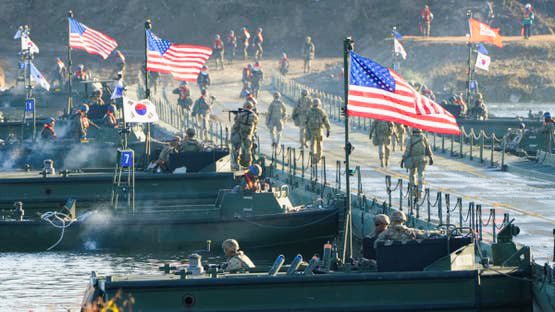South Korean President Yoon Suk-yeol announced that his country is hesitant to grant "greater flexibility" to U.S. forces stationed on its territory, indicating its refusal to allow Washington to make changes to the locations, movements, and training of its forces without full coordination with the South Korean government.
The Yonhap news agency reported the South Korean president saying, during his visit to Washington, that his country finds it difficult to accept this U.S. request, which it sees as a threat to its national sovereignty.
"Flexibility" means that U.S. forces would have the freedom to reposition their troops or change their military training schedule without undergoing approval procedures from Seoul.
Yoon Suk-yeol is scheduled to meet with U.S. President Donald Trump at an upcoming summit, where they will discuss national security issues, sharing defense spending, along with reviewing the details of the trade agreement reached between the two countries last July.
* F-35s in South Korean Skies Again
In a related context, U.S. forces in South Korea announced a temporary deployment of F-35 fighter jets as part of the annual joint military exercises with Seoul, known as "Ulchi Freedom Shield" (UFS), which lasts for 11 days and ends next Thursday.
An American military official stated that about 10 aircraft of the F-35A and F-35B models were deployed at Kunsan Air Base to participate in maneuvers aimed at enhancing defensive coordination and deterrence against regional threats, primarily North Korea, which recently conducted tests on two new missiles with "superior" combat capabilities.
_ The two fighters are fifth-generation key elements in the U.S. Air Force arsenal:
F-35A: Operates from conventional runways and features higher maneuverability and greater payload.
F-35B: Designed for the Marine Corps and features short takeoff and vertical landing capabilities, giving it significant operational flexibility even from ships or rugged bases.
* Strengthening Joint Defensive Posture Amid Strategic Changes
Observers believe that the deployment of these aircraft comes as part of enhancing joint readiness between Seoul and Washington, especially with the transfer of some U.S. Patriot batteries to the Middle East, necessitating the filling of defensive gaps by periodically deploying fifth-generation fighters in the region.
The commander of U.S. forces in South Korea, General Xavier Brunson, recently confirmed that "the priority is not numbers but capabilities," referring to a new direction in U.S. military deployment strategy on the Korean Peninsula, focusing on enhancing combat capability rather than just the number of troops.
When asked about the possibility of converting this temporary deployment into a permanent or regular rotational deployment of F-35 fighters, the American military official stated that options are under continuous evaluation, emphasizing that any adjustment in troop status will be officially announced through the appropriate channels.
South Korea insists on its sovereignty and refuses to grant Washington an open mandate for its troop movements, while the United States is moving to enhance its air presence by deploying advanced fighters amid rising tensions with North Korea and changes in regional defense balances.

